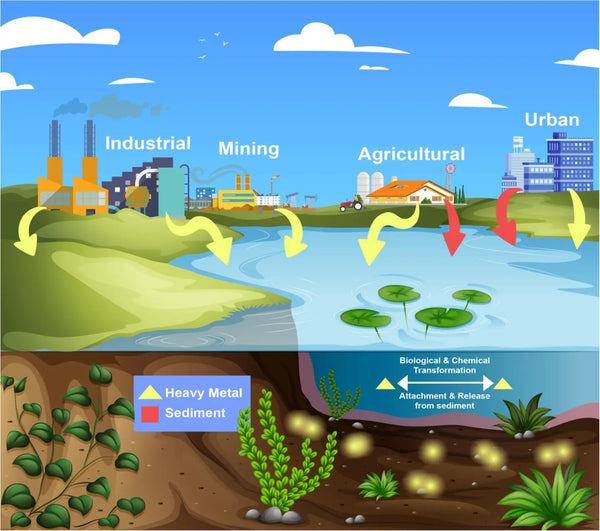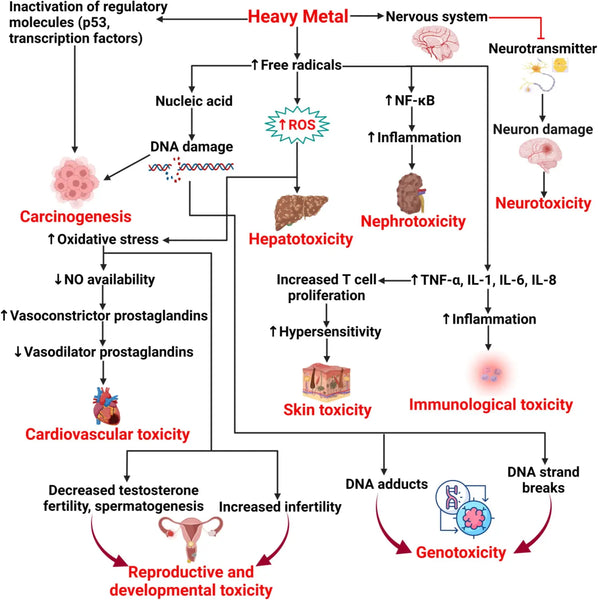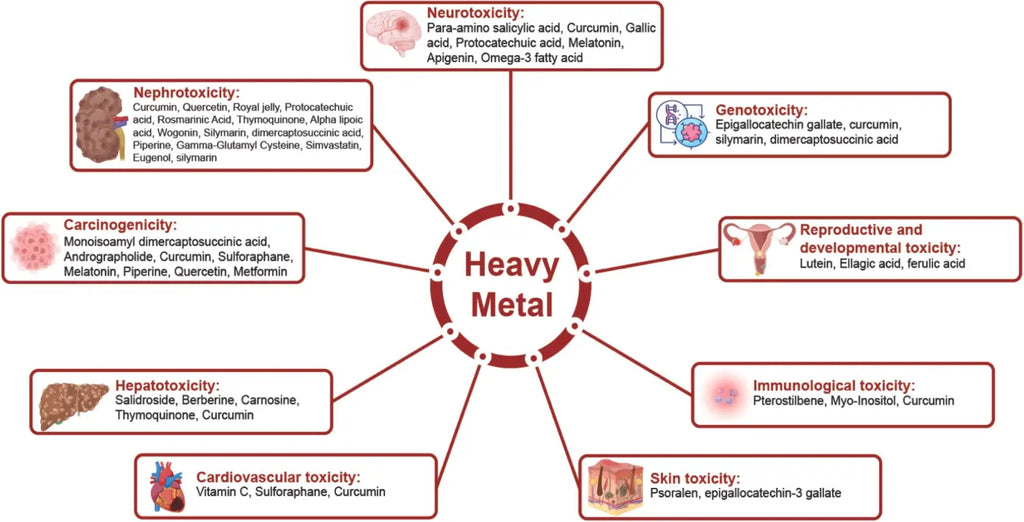Environmental toxins are pervasive in our surroundings, and exposure to them can harm our health. This comprehensive scientific review explores the various environmental toxins and their harmful impact on the human body. From heavy metals and pesticides to air pollutants, we examine the risks and consequences of exposure, including developmental delays, neurological disorders, and cancer. By understanding environmental toxins' impact, we can reduce our exposure and protect our health.
Introduction
Environmental toxins are chemical substances or compounds that can cause harm to living organisms and the environment. They also refer to chemical compounds or elements in the air, water, food, soil, dust, or other environmental media such as consumer products such as cosmetics. These toxins are often produced due to human activities, such as industrial processes, transportation, and agriculture, and can be found in various forms, including gases, liquids, and solids.

Environmental toxins According to CDC’s National Biomonitoring Program (NBP), more than 400 environmental chemicals or their metabolites were measured in human samples (e.g., urine, blood, serum, or breast milk). Also, toxins from bacteria, fungi, algae, and plants are reportedly the most deadly chemicals.[1]
Environmental toxins can also significantly impact ecosystems, including the contamination of soil, water, and air and the disruption of natural habitats and wildlife. These toxins can accumulate in the food chain, leading to bioaccumulation and biomagnification, which can have severe consequences for the health of animals and humans.
Environmental chemicals, in particular, have a wide range of adverse effects on human health. These include endocrine system disruptions, autoimmune conditions, neurodegenerative diseases, obesity, allergies, asthma, cognitive decline, metabolic disorders, infertility, autism, and cancer, to name but a few.[2-7]
List of environmental chemicals:[8]
- Acrylamide
- Cotinine
- N,N-Diethyl-meta-toluamide (DEET)
- Dioxin-Like Chemicals
- Disinfection By-Products (Trihalomethanes)
- Environmental Phenols
- Benzophenone-3
- Bisphenol A (BPA)
- Triclosan
- 4-tert-Octylphenol
- Fungicides and herbicides
- Sulfonylurea herbicides
- Heavy metals (see more comprehensive list below)
- Insecticides and Pesticides
- Micro- and nanoplastics[9]
- Microplastics 0.1–5000 µm in size
- Nanoplastics < 0.1 µm in size
- NNAL (4-(methylnitrosamino)-1-(3-pyridyl)-1-butanol)
- Non-Dioxin-Like Polychlorinated Biphenyls (PCBs)
- Parabens
- Perchlorate
- Perflourochemicals (PFCs)
- Phthalates
- Benzylbutyl Phthalate
- Di-2-ethylhexyl Phthalate
- Dicyclohexyl Phthalate
- Diethyl Phthalate
- Di-isononyl Phthalate
- Dimethyl Phthalate
- Di-n-butyl Phthalate/Di-isobutyl Phthalate
- Di-n-octyl Phthalate
- Polybrominated Diphenyl Ethers (PBDEs) and Polybrominated biphenyl (PBB)
- Polycyclic Aromatic Hydrocarbons (PAHs)
- Volatile Organic Compounds (VOCs)
- Benzene3
- Methyl tert-Butyl Ether (MTBE)
- Styrene
List of biological toxins from living organisms:[10]
- Aflatoxins produced by many species of the fungus Aspergillus,
- Commonly contaminates corn (maize) and other types of crops during production, harvest, storage or processing
- At high doses and over long periods causes acute and chronic liver injury and liver cancer
- Amanitin toxins produced by the poisonous death cap mushroom (Amanita phalloides)
- Health effects may include liver and kidney failure and death
- Anthrax lethal toxin produced by Bacillus anthracis
- The anthrax toxin proteins, including anthrax lethal factor, work together to disrupt a cell’s defense system.
- Botulinum toxin produced by Clostridium botulinum
- One of the most poisonous substances known to date.
- Causes botulism – a severe muscle-paralyzing disease
- Pertussis toxin produced by the Bordetella pertussis bacteria
- Causes whooping cough
- Staphylococcal enterotoxin B (SEB)
- Most often associated with food poisoning
- Saxitoxin and neosaxitoxin produced by several species of marine and freshwater algae and blue-green algae (cyanobacteria)
- High concentrations may build up in filter-feeding shellfish, such as clams and oysters
- Vomitoxin (deoxynivalenol), diacetoxyscirpenol, and T-2 and HT-2 toxins from fungi and algae
- These mycotoxins affect up to 25 percent of the world’s grain supply
For non-metal toxins, consider doing a toxic non-metal chemical profile (GPL-TOX) that screens for the presence of 173 different toxic chemicals including:
- Organophosphate pesticides
- Phthalates
- Benzene
- Xylene
- Vinyl chloride
- Pyrethroid insecticides
- Acrylamide
- Perchlorate
- Diphenyl phosphate
- Ethylene oxide
- Acrylonitrile
Also, if you have been exposed or you think there might be a possibility of exposure to mycotoxins, consider doing either a urine test (MycoTOX profile) or blood IgE test to find out whether you have been exposed to mycotoxins or created an allergic response to mold. MycoTOX uses mass spectrometry (MS/MS) technology, which is able to detect lower levels of fungal toxins.[11]
The test is also used for follow up testing to ensure that detoxification therapies have been successful. Testing for IgE mold antibodies (and possibly for IgG mold antibodies, to find out past exposure) is useful for individuals who suspect that they are reacting to an environmental stimulus.[12] Mold can exist either indoors (household plants and damp places) or airborne outdoors (peak levels in late summer and early fall). Also notice that warmer, humid climates can have elevated mold counts year-round.[13]
Heavy metal toxicity
Heavy metals are elements that have an atomic number greater than 20 and atomic density above 5 g/cm3 and must exhibit the properties of a metal. Heavy metals grossly divide into two categories: essential and nonessential heavy metals. Essentials are those required by living organisms for performing the fundamental processes like growth, metabolism, and development of different organs (such as copper, iron, cobalt, manganese, zinc and nickel).[14]

Figure: Diagrammatic explanation about heavy metals in the environment.
Source: Mitra, S. et al. (2022). Impact of heavy metals on the environment and human health: Novel therapeutic insights to counter the toxicity. Journal of King Saud University-Science, 101865.
Many nonessential heavy metals can be toxic to humans (such as arsenic, mercury, lead, cadmium and antimony). Exposure to these metals has increased industrial and anthropogenic activities and modern industrialization.
Contamination of water and air by toxic metals is an environmental concern, and hundreds of millions of people worldwide are affected. Food contamination with heavy metals is another concern for human health. Heavy metals and other environmental pollutants may also occur naturally and remain in the environment. Human exposure to metals is thus inevitable. The toxic mechanisms of heavy metals manifest via reactive oxygen species (ROS) generation, enzyme inactivation, and suppression of the antioxidant defense system.[15]
Occupational and industrial exposure, or exposure through various hobbies, may put people at higher risk for heavy metal toxicity.[16-17]
Those most at risk include workers in industries such as:
- Metal refining
- Alloying (combining metals with other substances)
- Electronics and computer manufacturing
- Parts manufacturing in aerospace and machine tools
- Pesticide manufacturing and application,
- Welding (fabrication process whereby two or more parts are fused together by means of heat, pressure or both forming a joint as the parts cool)
- Plumbing
- Construction
- Oil refining
- Firearms and ammunition
- Mining
- Waste disposal
- Pigment and coating manufacturing
- Petrochemical production
- Work with glass, dyes, ceramics, or paints
- Dentistry
Everyday activities and your environment may also be a risk factor for increased exposure to toxic heavy metals. These include:
- Groundwater and air contamination can distribute metals
- Usually in close proximity to industries mentioned in the list above
- Consumption of foods contaminated with metals (such as certain seafood or rice)
- Rice -> arsenium
- Seafood -> mercury
- Supplements from manufacturers who lack good manufacturing practice (GMP) and aren’t lab tested for heavy metals and other toxins
- Smoking (active and passive)
- Homes with older wells, pipes, and building materials,
- Personal care products and cosmetics
- Certain medications
- Exposure to emissions and exhaust fumes
- Exposure to paints, dental amalgams and fireworks
Once a toxic heavy metal enters the body, it is either eliminated through feces, bile, urine, sweat, hair, and nails or deposited into tissues. That can result in long-term storage. However, measuring tissue accumulation (or "total body burden") is challenging.[18]

Figure: Mechanisms of heavy metal toxicity in humans.
Source: Mitra, S. et al. (2022). Impact of heavy metals on the environment and human health: Novel therapeutic insights to counter the toxicity. Journal of King Saud University-Science, 101865.
Toxic heavy metals can be measured in various sample types such as blood, urine, hair, and nails as the most accessible tissues to quantify exposure. However, multiple variables (such as half-life, dose, time, kinetics, and route) impact the appropriate sample type. Clinical practitioners usually do two tests: a pre- and post-provoked sample (urine or blood) to distinguish recent exposure from tissue storage. Random urine samplings or timed collections provide beneficial information to screen for exposures. Hair and/or fingernails, potential routes of elimination for toxic elements, can be useful specimens for detecting an exposure that occurred in the month or more prior to specimen collection. Detection of elements in hair and nails is somewhat correlated to half-life of the elemental form.[19]
Genova Diagnostics Toxic Element Clearance Profile Analytes (urine ratioed to creatinine) includes:[20]
- Lead
- Mercury
- Aluminum
- Antimony
- Arsenic
- Barium
- Bismuth
- Cadmium
- Cesium
- Gadolinium
- Gallium
- Nickel
- Niobium
- Platinum
- Rubidium
- Thallium
- Thorium
- Tin
- Tungsten
- Uranium

Figure: Diagrammatic explanation of heavy metal toxicity treatment by natural bioactive molecules.
Source: Mitra, S. et al. (2022). Impact of heavy metals on the environment and human health: Novel therapeutic insights to counter the toxicity. Journal of King Saud University-Science, 101865.
Strategies to support natural heavy metal detoxification in the body:[21-23]
- Optimizing nutritional status of the whole body for detoxification
- Micronutrients (zinc and selenium, in particular)
- Essential amino acids
- Inflammation-lowering fatty acids (omega-3, EVOO etc.)
- Certain protective phytochemicals may also help (quercetin, catechin, anthocyanin, astaxanthin, curcumin, resveratrol, ferulic acid, chrysin and naringenin)
- Optimizing gut function and fixing intestinal permeability
- Eliminate all food allergens
- Digestive enzymes and certain probiotic strains[24] (such as Bacillus species, which seems to be particularly effective in removing toxic heavy metals)[25]
- Certain fibers that increase gut motility and defecation
- Using enough magnesium to help increase bowel movements
- See specific guidelines of this from the Biohacker’s Handbook
- Enhancing liver detoxification pathways (Phase 1 & Phase 2 – described in detail in the Biohacker’s Handbook)
- Methylated B vitamins (B6, folate & B12)
- Eating daily sulfur-containing foods (onions, broccoli, collard greens, kale, garlic, eggs etc.)
- Glutathione, N-acetylcysteine, milk thistle (silymarin), taurine and R-lipoic acid
- Chlorella, spirulina, microalgae[26] and cilantro may also help
- Regular sweating via exercise and heat (e.g. sauna and infrared sauna)
- See the specific infrared sauna & niacin protocol for heavy metal detoxification from the Biohacker’s Handbook
- Drinking lots of mineral-rich fluids and using electrolytes
- In general, optimizing all the toxin elimination routes in the body:
- Sweat
- Urine
- Stool
- Chelation agents (always consult a medical expert before using these)
- DMSA , DMPS and EDTA
- Endogenous chelation agents include glutathione and metallothionein
- Consider removing possible amalgam (mercury) fillings with a professional biological dentist
Conclusion
Environmental toxins pose a significant risk to human health, and their impact cannot be ignored. This comprehensive scientific review highlights the various environmental toxins humans can be exposed to and their harmful effects on the body. The review emphasizes that toxins can accumulate in the food chain, leading to bioaccumulation and biomagnification, with severe consequences for animals and humans. By understanding the risks and consequences of exposure to environmental toxins, people can take steps to reduce their exposure and protect their health.
References:
- Natural Biomonitoring Program. (2021). Environmental Chemicals. Centers for Disease Control and Prevention.
- Crinnion, W. (2000). Environmental medicine, part one: the human burden of environmental toxins and their common health effects. Alternative Medicine Review 5 (1): 52–63.
-
National Biomonitoring Program. (2017). Toxins. Centers for Disease Control and Prevention.





